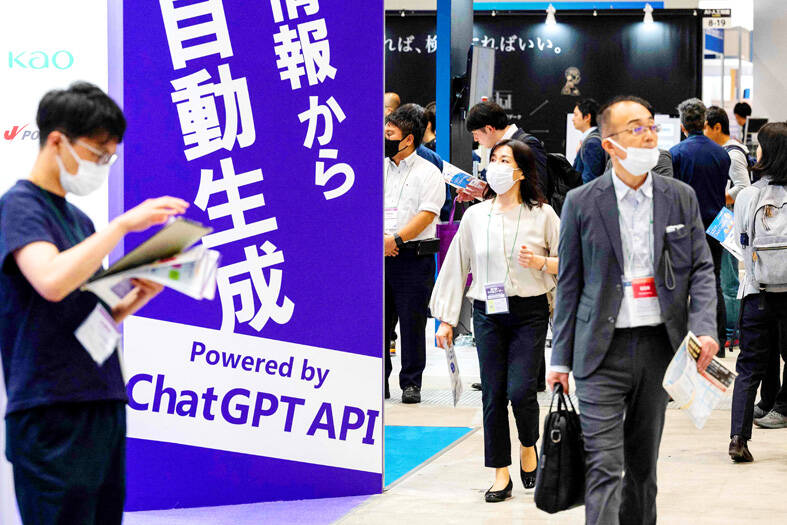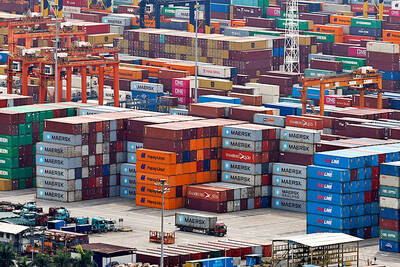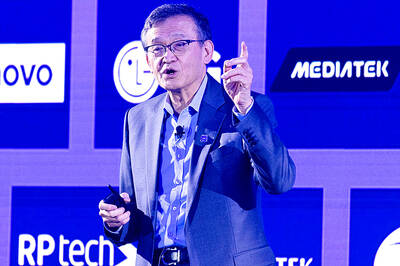Massive overseas and domestic investments offer Japan a chance to reclaim its tech crown, but to become a convincing alternative to China the country must embrace rapid innovation, experts say.
US tech giants are pumping billions of dollars into artificial intelligence (AI), cybersecurity and chip production in Japan, which dominated the hardware industry in the 1980s.
Google launched a regional cyberdefense hub in the country last month, and Amazon Web Services Inc is spending US$14 billion to expand Japanese cloud infrastructure.

Photo: AFP
In the latest move, Microsoft Corp, a partner of ChatGPT-maker OpenAI, this week pledged US$2.9 billion to boost the nation’s AI prowess.
“Geopolitical tensions have made Japan a more attractive and stable partner compared to China,” said Khos-Erdene Baatarkhuu, CEO of fintech company AND Global.
“Japan’s tech sector, once a leader, lost ground due to a slower response to digital and mobile trends” compared with neighbors such as South Korea, he said.
“Now, with supportive government policies, resilient start-ups and a potentially shifting global tech scene, Japan has an opportunity to regain its tech edge,” he said.
It is not there yet. Japan was ranked a lowly 32nd in the latest global classification of digital competitiveness by Swiss business school International Institute for Management Development.
Only seven Japanese firms appear among more than 1,200 tech “unicorns” — start-ups worth more than US$1 billion — listed by CB Insights.
A “perfection-seeking approach” and preference for “stability and gradual improvement” among businesses is partly to blame, Khos-Erdene said. “The traditional corporate culture in Japan tends to be risk-averse and hierarchical, which can stifle the rapid innovation typically seen in the software industry.”
Masayoshi Son, CEO of Japanese tech investment vehicle SoftBank Group Corp, has said the country could be left a gawping “goldfish” if it ignores AI.
“Wake up Japan,” he said at a corporate event in October last year. “I want to be on the side of evolution.”
Son and tech titans including Apple Inc CEO Tim Cook and Amazon.com Inc founder Jeff Bezos joined Japanese Prime Minister Fumio Kishida and US President Joe Biden at a Washington dinner on Wednesday.
At a summit that day, Kishida and Biden vowed to bolster “our shared role as global leaders in the development and protection of next-generation critical and emerging technologies.”
They also agreed to work with “like-minded countries to strengthen global semiconductor supply chains” in a joint statement.
Semiconductors, which power everything from cellphones to cars, have become a key battleground in the past few years.
The US and some European countries have blocked exports of high-tech chip technology to China over fears of military use.
Meanwhile, Taiwanese chip behemoth Taiwan Semiconductor Manufacturing Co (TSMC, 台積電) is facing pressure to diversify its production from customers and governments worried about the possibility of China invading Taiwan.
TSMC opened a US$8.6 billion chip factory in southern Japan in February, and is planning a second, US$20-billion facility for more advanced chips.
On a visit to the TSMC plant this month, Kishida said he “felt firsthand the revival of our country’s semiconductor industry.”
Japan has spent ¥3.9 trillion (US$25.44 billion) in the past three years on chip-related subsidies — a larger portion of GDP than the US or Germany.
Japanese firms including Sony Corp and Toyota Motor Corp are also collaborating with US giant IBM Corp on a semiconductor project called Rapidus, aiming to mass-produce 2-nanometer logic chips in Japan from 2027.
“This is a great time to invest in Japan” with the yen’s value at a 34-year low, said Hideaki Yokota, vice president of the specialist information technology think tank MM Research Institute.
Tech firms hope the country can become their “best partner in Asia” while its workforce boasts many highly educated engineers ready to be snapped up, he said.
Established Japanese businesses, especially in the auto and household appliance sectors, provide real-world opportunities to make AI profitable, he said.
However, Khos-Erdene said that Japan should not rely on its legacy as a manufacturer, given its low labor productivity and shrinking workforce.
“As CEO of a tech company, I see Japan at a crossroads,” he said, with the question not if but how quickly the country can become a “producer, not just a consumer, of these transformative technologies.”
Microsoft plans to offer AI training to 3 million of Japan’s population of 125 million.
Japanese and US universities are also teaming up on new technology research programs funded by global companies such as Nvidia Corp and Arm Holdings PLC.
“Overall, Japan’s commitment to AI holds tremendous potential for economic revitalization,” Khos-Erdene said. “By fostering collaboration, retaining top talent, and learning from successful models like the US and China, Japan can bridge the AI gap and re-establish itself as a major force in the global tech landscape.”

The Eurovision Song Contest has seen a surge in punter interest at the bookmakers, becoming a major betting event, experts said ahead of last night’s giant glamfest in Basel. “Eurovision has quietly become one of the biggest betting events of the year,” said Tomi Huttunen, senior manager of the Online Computer Finland (OCS) betting and casino platform. Betting sites have long been used to gauge which way voters might be leaning ahead of the world’s biggest televised live music event. However, bookmakers highlight a huge increase in engagement in recent years — and this year in particular. “We’ve already passed 2023’s total activity and

Nvidia Corp CEO Jensen Huang (黃仁勳) today announced that his company has selected "Beitou Shilin" in Taipei for its new Taiwan office, called Nvidia Constellation, putting an end to months of speculation. Industry sources have said that the tech giant has been eyeing the Beitou Shilin Science Park as the site of its new overseas headquarters, and speculated that the new headquarters would be built on two plots of land designated as "T17" and "T18," which span 3.89 hectares in the park. "I think it's time for us to reveal one of the largest products we've ever built," Huang said near the

China yesterday announced anti-dumping duties as high as 74.9 percent on imports of polyoxymethylene (POM) copolymers, a type of engineering plastic, from Taiwan, the US, the EU and Japan. The Chinese Ministry of Commerce’s findings conclude a probe launched in May last year, shortly after the US sharply increased tariffs on Chinese electric vehicles, computer chips and other imports. POM copolymers can partially replace metals such as copper and zinc, and have various applications, including in auto parts, electronics and medical equipment, the Chinese ministry has said. In January, it said initial investigations had determined that dumping was taking place, and implemented preliminary

Intel Corp yesterday reinforced its determination to strengthen its partnerships with Taiwan’s ecosystem partners including original-electronic-manufacturing (OEM) companies such as Hon Hai Precision Industry Co (鴻海精密) and chipmaker United Microelectronics Corp (UMC, 聯電). “Tonight marks a new beginning. We renew our new partnership with Taiwan ecosystem,” Intel new chief executive officer Tan Lip-bu (陳立武) said at a dinner with representatives from the company’s local partners, celebrating the 40th anniversary of the US chip giant’s presence in Taiwan. Tan took the reins at Intel six weeks ago aiming to reform the chipmaker and revive its past glory. This is the first time Tan